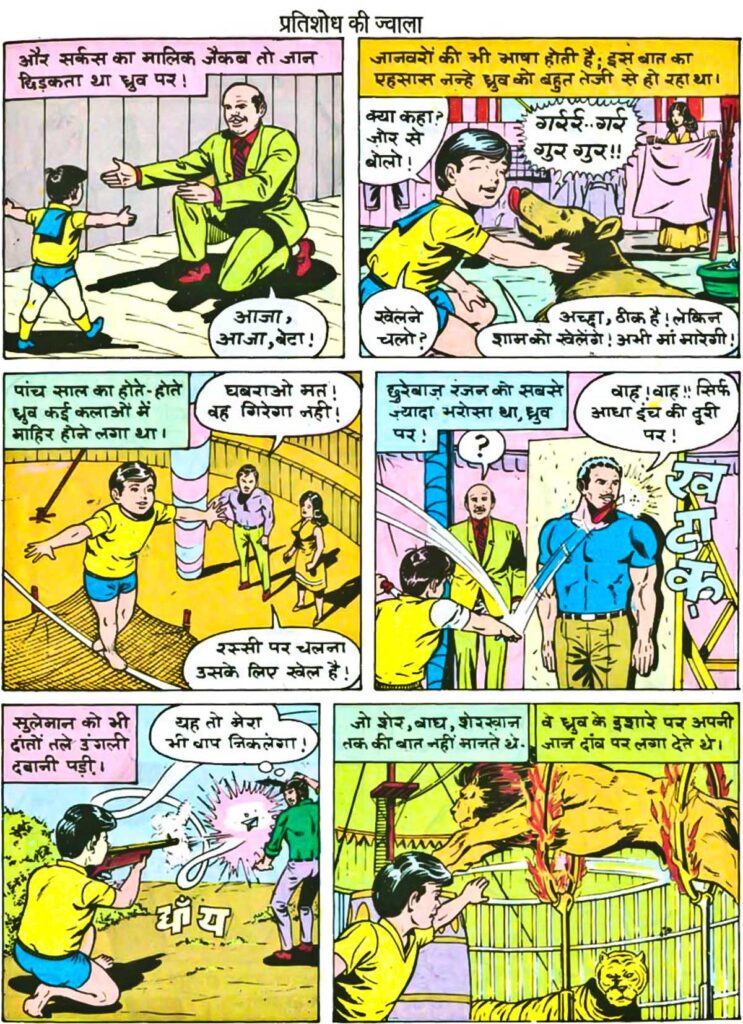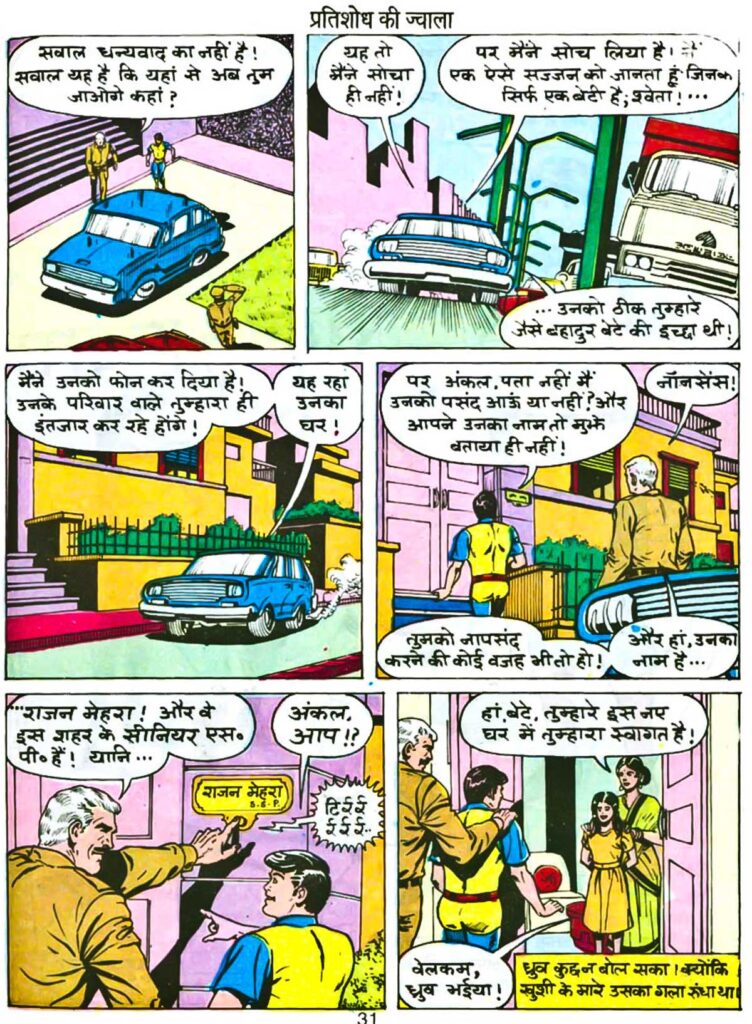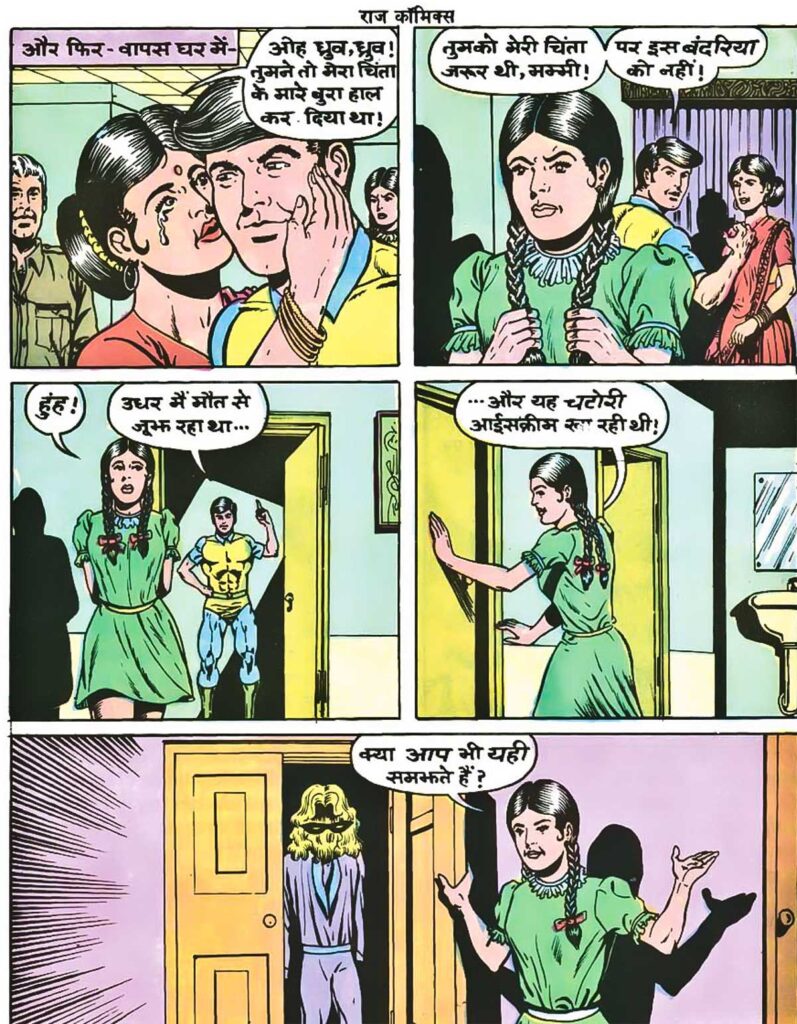The character created by Anupam Sinha, Super Commando Dhruv, made his debut in the fiery revenge of the Hindi language comic book “Pratishodh ki Jwala” in 1987. He resides in the fictional Indian city of Rajnagar, which is also a reference in the comic book line, Raj Comics, that publishes the Dhruv series. The literal meaning of Rajnagar is the city of kings or the world of kings. Till date, Dhruv remains one of the most popular superheroes in South Asian comics.
In Rajnagar, Jupiter Circus was a highly successful circus group. The presence of highly skilled performers and artists helped it surpass other circuses in competition, making it the number one circus in Rajnagar. Two of its most famous artists, Shyam and Radha, fell in love and soon got married. Some time later, they had a son whom they named Dhruv. Inheriting athletic skills as a legacy from his parents, Dhruv spent his childhood in the circus, learning various skills like martial arts, gymnastics, shooting, and archery. He also spent time with master artists, conversing with birds and animals. All these skills, combined with Dhruv’s sharp mind, made him proficient in these arts.

When Jupiter Circus was at its peak, the owner of Global Circus, due to heavy losses in business, employed thugs to destroy the entire circus. When the goons reached the Jupiter Circus camp, they set fire to the entire camp. As a result, all circus staff and artists were killed, and its property was destroyed. Dhruv was not present at the camp at that time. Upon returning, he witnessed the charred bodies of his parents and loved ones. There, he heard from the goons about the success of their plan as they spoke to the rival circus owner. Filled with tears in his eyes and a desire for revenge in his heart, Dhruv swore to avenge the tragedy and soon sent all the culprits behind bars.

Police Commissioner Rajan Mehra was so impressed by his bravery that he decided to adopt Dhruv; a decision welcomed enthusiastically by his wife Rajni and their daughter Shweta. Dhruv utilized the money received from insurance to establish the “Commando Headquarters” and financially support his endeavors. The headquarters houses a “Commando Force,” a unit dedicated to combating crime, comprising three National Bravery Award-winning individuals selected by Dhruv—Peter, Karim, and Renu. While Karim is a telecommunications specialist, Peter and Renu assist Dhruv in combat skills and solving crimes, addressed by him as “Captain.” The Commando Headquarters is equipped with state-of-the-art technology to aid in forensic analysis, global surveillance, and handling other units involved in crime prevention.
Super Commando Dhruv is a superhero without explicit superpowers. He primarily fights his battles using ordinary objects around him, some general knowledge, and fundamental scientific principles. Initially, Dhruv had no additional weapons besides the Star Blade (a blade in the shape of a star), which he threw at his enemies. However, in terms of Dhruv’s strength, his sister Shweta provided him with a new set of gadgets. This includes two bangles, one for shooting the Star Blade and the other for retrieving the Star Line (a metal wire with a star at the end), a Star Belt containing a Star Transmitter (keeping Dhruv connected to the Commando Headquarters and other important city contacts via radio frequency), acid, and a mystical gas capsule. In addition to these, Dhruv’s shoes have folding roller skates. But above all, Dhruv’s quick and intelligent mind works as his most powerful weapon.

Apart from being a technical sorceress, Shweta also comes to Dhruv’s aid as Chandika, the destroyer. She makes her first appearance in the devastation of heaven as Chandika and, like Dhruv, has no superpowers. However, she relies on her physical agility and intelligence to fight against enemies. Interestingly, Dhruv is unaware of Chandika’s true identity. The only person who knows is his girlfriend, Natasha. What adds an intriguing twist is that Natasha is the daughter of Dhruv’s arch-enemy, Grand Master Robo.
Grand Master Robo is a global terrorist possessing a half-metal body and a laser eye that can destroy any living thing.Robo’s wife, Marianne, is a retired nurse who distanced herself from him due to his underworld dealings.
In the beginning, Dhruv’s stories were espionage-based narratives, incorporating elements of science fiction. With the success of special issues, Raj Comics discontinued the publication of regular issues for their top two heroes, Dhruv and Nagraj, while continuing to publish regular issues for other superheroes. From 1991 to 1995, the frequency of Dhruv’s standalone regular issues decreased, while the frequency of special issues increased.
GENL #585 “Chandakaal Ki Wapasi,” published in 1995, marked the last standalone regular issue for the character. Since then, Dhruv has been seen only in special issues. With this shift from regular issues to special issues and the move from general topics to special themes, Sinha’s storytelling style for Dhruv’s comics also underwent a change. Dhruv’s comics now include more science fiction-based tales, focusing on time travel and space adventures.
Instead of just fighting thugs, Dhruv was now battling not only villains but also aliens and even demons. He was no longer solving petty crimes but rather saving the world from major threats. While some fans expressed discontent with this transformation of the character, the majority accepted and embraced the change. Despite the flood of science fiction/mythological superhero activities, Sinha made an effort not to lose the essence of the character’s core.
Between these superhero exploits, Sinha brought forth some well-received and critically acclaimed issues exploring Dhruv’s personal life and the human side of his character. One such issue was SPCL #64 “Commander Natasha,” published in 1996. This issue delved into Dhruv’s love life, creating upheavals and ultimately concluding with Natasha leaving Dhruv and joining Robo’s criminal syndicate once again. This story was connected to Robo and Natasha’s past and ended with Natasha rejoining Robo’s criminal syndicate.
While Dhruv’s origin was made clear in his early appearances, there wasn’t much information about his family background. In 1997, the landmark issue SPCL #100 “Khooni Khandaan” was a historic publication in many ways. Not only was it the 100th special issue published by Raj Comics, but it also marked the first issue of a prestigious three-part series related to Dhruv’s family background. In this issue, Dhruv discovered that his biological father was actually a French citizen wanted for murder. This revelation led Dhruv on an emotional journey to prove his late father’s innocence and remove the stain of being a murderer from his name.
SPCL #2245 “Gupta,” without the arrogance of being a superhero, deals with the complexities and consequences of being one. A new overseer, Alchemist, targets Dhruv’s foster family, forcing him to contemplate whether becoming a crime fighter without a secret identity and putting his family at risk was a mistake.
These issues showcased the multidimensional aspects of Dhruv’s character, exploring his emotional struggles, family ties, and the consequences of his superhero identity on those around him.

Around the year 1995, when Sanjay Gupta was busy developing a new superhero, Doga, he assigned the task of writing and illustrating Nagarakshak (Nagaraj) to Anupam Sinha. This marked one of the biggest superhero collaborations in Raj Comics. Despite Dhruv and Nagaraj being individually popular, their first two joint ventures, both written by Sanjay Gupta, were not successful. In 1996, Sinha brought SPCL #67 “Rajnagar ki Tabahi” (Destruction of Rajnagar). This massive 90-page issue brought the two superheroes together for the third time but for the first time under Anupam Sinha’s writing. It became a significant critical and commercial success for Raj Comics. In 1997, Raj Comics declared it as the Nagaraj-Dhruv Double Action Year. During this year, all Raj Comics heroes appeared together in two crossover issues. As part of the celebration, Nagaraj and Dhruv were also featured in two solo hero issues, “Pralay” and “Vinaash,” each consisting of 90 pages. Since then, Nagaraj and Dhruv have been seen together in several two-hero and multi-hero issues, all of which have been highly successful. Raj Comics’ most ambitious and significant project, “Nagayana,” a visionary series based on the Hindu epic Ramayana, was published for three years from 2007 to 2009. This alternative universe consisted of 8 parts and featured the unique combination of Nagaraj and Dhruv. Fans have compared the Nagaraj-Dhruv partnership to the DC Comics’ Superman-Batman partnership, both being collaborations between an invincible superhero and a superhero without any supernatural powers.
Dhruv comes across as a humble, gentle, and down-to-earth personality. He is soft-spoken and has a mild nature, always showing respect to his elders. He is consistently well-dressed, sporting buttoned collars and maintaining neat hair.
Anupam Sinha knew that as a superhero without any supernatural powers and without arrogance, Dhruv was perhaps the closest to reality in the world of comic book superheroes. He aimed to create a character that children could relate to, a character whose qualities they could emulate. Sinha wanted Dhruv to be an ideal for children. He wanted to show children that a person can be both firm and cultured at the same time. In Sinha’s words, “I wanted to show that a well-behaved and well-raised child should not be afraid of being called a ‘wimp.'”

This portrayal of Dhruv aimed to present a positive and relatable role model for children, encouraging good behavior and manners while challenging stereotypes associated with being well-behaved.
Sinha crafted Dhruv’s character to embody a strong moral and ethical image. Dhruv demonstrates deep respect for human life, refrains from taking the law into his own hands, and consistently collaborates with law enforcement agencies to uphold justice. As the protector of Rajnagar city, he believes in capturing criminals alive and letting the legal system determine their punishment.
Dhruv’s commitment to non-violence is evident, even when facing female adversaries. He attempts to subdue them without causing physical harm, showcasing a principled approach to conflict resolution. Sinha intended Dhruv to serve as a role model for children, emphasizing the importance of good behavior, respect for others, and adherence to ethical principles.
Dhruv’s character is characterized by humility and a grounded personality. His choice of clothing, neat appearance, and well-mannered demeanor contribute to his positive image. Sinha wanted Dhruv to be relatable to children, encouraging them to emulate his qualities. Dhruv’s uniqueness lies in being a superhero without supernatural powers, fostering a sense of realism and relatability.
In addition, Dhruv’s portrayal reflects a strong commitment to gender sensitivity. Despite having numerous female admirers, Dhruv maintains a clear focus on Natasha, his first love. This aspect of his character underscores his dedication and loyalty, reinforcing positive relationship values.
Overall, Anupam Sinha successfully created Dhruv as a superhero who stands out for his moral integrity, commitment to justice, and a relatable, down-to-earth personality.
